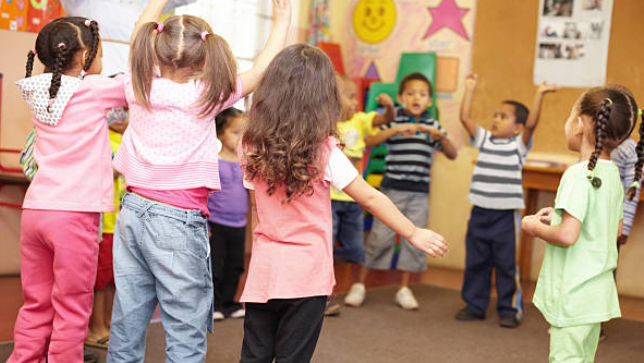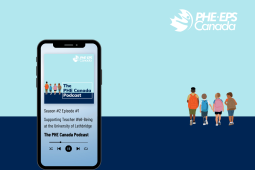Brand-New Resources for Successful Dance Education

Previously published in Volume 82, Issue 4
For the past three years, members of the PHE Canada Program Advisory Committee for Dance Education (Dance PAC), have been working in partnership with Canada’s National Ballet School (NBS) and the Royal Winnipeg Ballet School (RWB) on the development of a project called Sharing Dance in the Classroom.
What is Sharing Dance in the Classroom?
Sharing Dance began as a flash mob, a familiar cultural phenomenon. In celebration of NBS’ 50th anniversary in 2009-2010, the school embarked on the creation of a piece of choreography that would be accessible to the community around the ballet school and would enable them to celebrate their milestone anniversary in an inclusive way. Unbeknownst to the staff at the ballet school, teachers working in classrooms also accessed the instructional YouTube videos they had produced for the anniversary flash mob, teaching the dance to their classes and using it to support their delivery of the dance curriculum in their home provinces, far away from downtown Toronto.
This novel use of their in-house resources surprised the NBS staff and alerted them to a need within schools across Canada; classroom teachers were eagerly searching for resource materials that would allow them to successfully teach dance in their classrooms, a subject for which, in many cases, they felt ill-prepared. The same need was identified by their colleagues in Winnipeg. NBS then approached PHE Canada with the idea of producing a broad suite of resources for teachers in Elementary schools.
Their proposal came at a fortuitous moment, as the Dance PAC had been discussing the same challenges of professional development in dance during our regular meetings. Throughout this project, members of the Dance PAC have served in a variety of roles, from advising on the direction of the project to the actual creation of the resources. We are thrilled to announce that many of those resources are now available for teachers to access, free of charge, through the online Sharing Dance portal.
Resources for teaching dance successfully
These resources represent a significant step forward for dance education in this country as they address not only what to teach but also include suggestions for how to teach dance successfully, as well as providing music for each lesson and unit plan.
The Sharing Dance in the Classroom resources include:
- Free unit plans with three to five lessons each
- Short video lessons including teaching prompts and clips of students working on the lesson
- Custom-composed music for each unit
- An opportunity to interact with experienced dance teachers, ask questions, and build a community of learners working in Canadian dance education
The first round of units includes topics such as:
Energy
This unit helps students develop a practical understanding of using different energies when dancing. Throughout the unit, students will be given the opportunity to move with strong, sudden motions as well as with light, soft movements. In addition, students will gain an understanding of action/reaction movement and how those can be effectively used in choreography. This unit also gives students an opportunity to create their own movement sequences and provides the framework for self-reflection and assessment.
Dancing rocks!
This unit explores geology, finding inspiration from crumbling sedimentary rock, flowing magma and forceful metamorphic rock. The students work with shape and energy as they learn the Rocks Dance. Finally, students work in groups to create their own movement phrase, which can be included in a final performance.
Poetry in motion
This unit finds inspiration in poetry. Onomatopoeia, alliteration, cacophony and euphony all play a role in helping students to find new ways of moving. The poetry dance begins with structured choreography but students quickly move on to creative group work, finding creativity within the structure of the overall dance.
The life cycle of a frog
This unit finds inspiration for dance creation in the life cycle of a frog. The movements of eggs, tadpoles and jumping frogs are used to inspire explorations of shapes, pathways and energy. This is a very active dance that ties in closely with fundamental movement skills and elements of physical literacy.
The maps dance
The maps dance invites students to find inspiration in the distinct geographic regions of Canada. Students learn about pathway and shape in dance while exploring the Boreal Shield and the Pacific mountains. At the end of this unit, students will be able to perform the maps dance, moving their way across an imagined Canadian landscape.
Cross-curricular ties
Cross-curricular connections are an important element across all Sharing Dance units. NBS, RWB and PHE Canada recognize this as being especially critical, given the pressure to deliver curricular objectives outside of the arts, physical and health education. Our hope is for these tools to further support student learning through movement.
The Sharing Dance team has also recently produced a series of dance videos that teachers can use as part of their Daily Physical Activity program but that also incorporate expectations from dance curricula across the country and engage students in dance movement that will both raise their heart rate and stretch their thinking. These direct-to-camera resources will be posted in the near future as will more video and audio-supported unit plans that are currently in development.
Sharing Dance at Canada's 150th
And if all of that weren’t enough, Sharing Dance has also been named one of 40 official #Canada150 events celebrating Canada’s sesquicentennial. This year’s Sharing Dance will offer a week of activities, spread across the country, culminating on June 2, 2017, Sharing Dance Day. You can join in the fun by hosting a Sharing Dance Day event in your school or community. Rehearsals are livestreamed and a simplified instructional video will also be available online. Visit www.nbs-enb.ca/Sharing-Dance/Sharing-Dance-Day-2017 to register your school or group today!
Now is a great time for Canadian dance education. New technology is allowing us to reach beyond classroom and studio walls to share expertise and realize growth that was once confined only to a few urban centres. Providing free access to the Sharing Dance in the Classroom resources breaks down financial barriers to teacher professional development in dance and enables wider distribution than has ever been possible.
Please visit www.sharingdance.ca, enroll in one of the online modules, and join the conversation!
References








